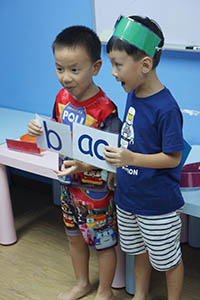Hanyu Pinyin is a key concern for K2 and P1 parents and we interview two of our teachers, Li lao shi and Liu lao shi, to understand common problems students face when learning Hanyu Pinyin and some of their secret tips to help kids master it.
Why is important for my child to have a strong Hanyu Pinyin foundation before entering P1?
There is a large emphasis on Hanyu Pinyin in P1, and some schools allocate up to 40% of the mid year assessment marks to Hanyu Pinyin. It doesn’t help that primary schools teach Hanyu Pinyin very quickly, and will start testing spelling of blended words (e.g. wà, yǔ yī, wá wa) by the second week of school.
From experience, K2 kids that do not have a strong foundation in Hanyu Pinyin are likely to struggle in P1, leading to diminished confidence and interest in Chinese as they fall behind their peers. In addition, the larger P1 class sizes (20-30 vs 10 in preschool) makes it harder for kids to catch up.
The preschool to primary school transition can be challenging for kids, and having a strong foundation in Hanyu Pinyin makes the transition easier since it gives kids a leg up in a critical component and also helps kids learn vocabulary faster since every word in the P1 textbook has accompanying Hanyu Pinyin.
What are some of the biggest problems P1 students face when learning Hanyu Pinyin?
The majority of marks lost on tests come differentiating vowel tones and blending consonants with vowels. The following diagram is a common P1 type of question where students have to mark the correct vowel tone, and students tend to mix up the second and third vowel tone.
Another common problem students face is how to properly blend consonants and vowels , and in the following set of questions, students need to recognise the words corresponding to each picture and write down the correct consonant.

How can I help my child learn Hanyu Pinyin?
Learning Hanyu Pinyin can be quite boring so it is important to help your child build interest first via fun activities, media and games (see the section below for an example of a game we use in class) before moving on to practice worksheets.
Typically, we recommend a three-step process when learning Hanyu Pinyin – start by ensuring your child fully understands and recognises the individual consonants and vowels (including different tones). It is important that your child masters this step before moving on to the harder steps.
We have compiled a list of Hanyu Pinyin songs on YouTube, and you can play it and have your child sing along (learning is far more effective if your child is actively singing along rather than passively listening). Once he or she is able to do this, we recommend testing your child on individual consonants and vowels (you can buy colourful Hanyu Pinyin charts at Popular, as well as the汉语拼音宝宝 flashcard series).
The next step is blending the consonants and vowels together to form a word. The way to master blending is through practice, and see below for the details of one of the games we use in class to make practice fun.
- Each child will hold on to a paper with either a consonant or a vowel. On a separate table, prepare four head pieces for each of the four tones.

- The teacher will pick one child to be the narrator and will show him or her a Hanyu Pinyin word (e.g. bō) on a piece of paper/portable whiteboard (only the narrator can see the word).
- The narrator will say out the word and the children holding the consonant and the vowel of the word (e.g. b and o) have to stand up.
- The child holding the vowel will have to go to the table with the four head pieces and select the head piece with the correct tone and wear it.
- Afterwards, each kid will say either the consonant or vowel he or she is holding up, and then say the final blended word.
Once your child is comfortable with blending, the final step is getting your child familiar with the Hanyu Pinyin questions tested in P1 through worksheet practice. Since many P1 Hanyu Pinyin questions also test students’ vocabulary (need to first recognise a picture or word before writing the corresponding Hanyu Pinyin), it’s important to ensure that your child is comfortable with the P1 vocabulary wordlist as well.
What if I want extra help?
If you would like some extra help on Hanyu Pinyin, KidStartNow is having a Hanyu Pinyin camp during the upcoming Dec holidays for K2 and P1 kids. The camp is from Nov 22-25, 11:30-1:30pm or Dec 13-16, 11:30-1:30pm and we only have a few vacancies left.
The camp will reinforce Hanyu Pinyin fundamentals, with a focus on typical problem spots faced by kids entering P1 like vowel tones and blending. The camp will include vocabulary exercises covering common words from the P1 syllabus to help kids get used to the P1 format and curriculum.
Sign up before 6st Nov 2016 to enjoy a special $30 discount ($285 vs normal price of $315) or sign up in groups of 3+ to enjoy a special rate of $260 per child($55 savings vs normal price of $315)! Leave us your details below and we will contact you within 2 working days.
[contact-form-7 404 "Not Found"]










